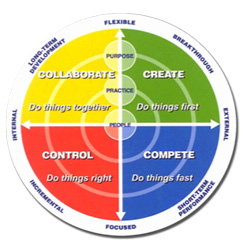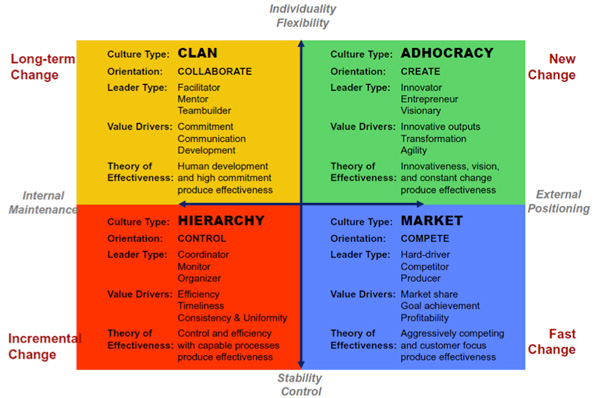
Earlier this year, I led the NAS team through a Competing Values Framework exercise. Each member of the staff filled out a questionnaire that took a snapshot of what they felt were the organization’s current and preferred values and mapped them onto a two-by-two matrix. The four quadrants of the matrix represent each of the “competing values” within an organization. (See the diagram below.)
The yellow “collaborate” quadrant represents values like loyalty, communication and human development. This is at odds with the values inherent in the blue “compete” quadrant whose focus is on goal achievement, customer-focus and profitability. The values in the red “control” quadrant emphasize consistency, policies and process. This is in opposition to the green “create” quadrant, which is all about innovation, agility and vision.
An additional take on the tensions inherent in the framework can be found along its axes. The horizontal axis maps an organization’s focus, with the quadrants on the left focusing primarily inside the organization and those on the right looking externally at customers and the outside environment. The vertical axis maps where decisions are made. The bottom quadrants represent a more hierarchical culture where control rests with the management. In the top quadrants you’ll find a more distributed leadership in which employees are more empowered to make decisions.
There is no recipe for the perfectly plotted organizational diagram. In fact, your organization’s shape should not be a constant. The idea is that as an organization grows and changes, so too must these competing values. And, the “competing” part is essential to remember. As an organization stretches further into one quadrant, it automatically contracts in its diagonal counterpart. The more you seek to be agile and innovative (green), the more you must let go of some control and consistency (red). If you are looking to move more quickly and focus more externally (blue), you will not be able to be as collaborative an organization (yellow).
Plotting the points in the quadrants, however, is only part of the process – the easy part. The framework is best used as the starting point for discussion. For us, the team came together to compare and discuss the mapped values. The tool gave us a common language that allowed us to talk in a neutral way about the current state of our culture and what values and characteristics the organization needed to move ahead. This allowed folks at all levels to feel comfortable voicing their opinion. It also allowed us to talk about the trade-offs involved in shifting these values. What does being more “blue” mean for an educational organization? How might that affect the collegial atmosphere of the team? What is the right level of “redness?”
This shared vocabulary is an invaluable asset for any organization. It gives everyone the means and the permission to address these questions and talk about the organizational culture in a constructive way.
In the video below, former NAS President and CEO, Russell Willis Taylor, and I talk about our experience using the Competing Values Framework.
For more information about The Competing Values Framework, visit competingvalues.com, a website featuring the work of Jeff DeGraff, a professor at the University of Michigan’s Ross School of Business and a faculty member for our Chief Executive Program.



